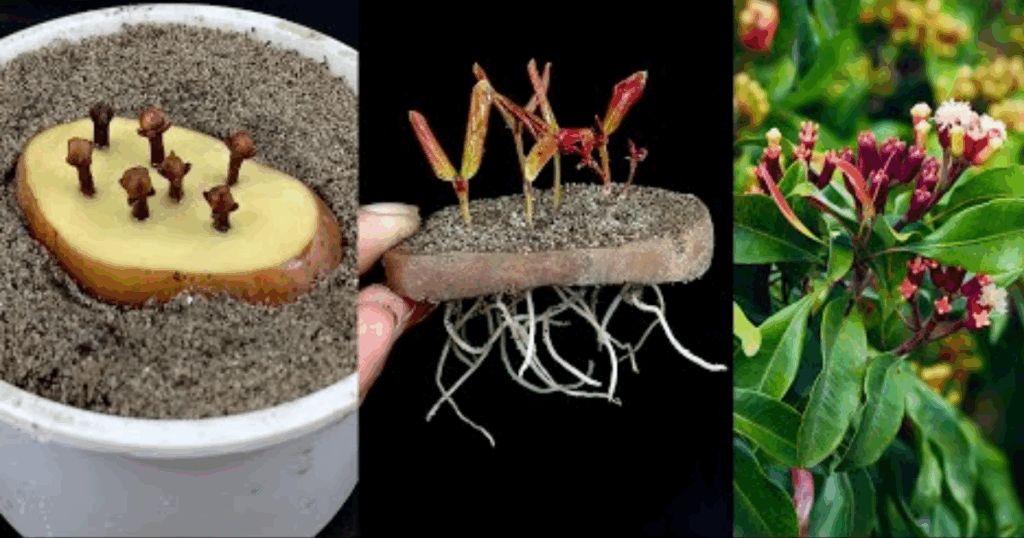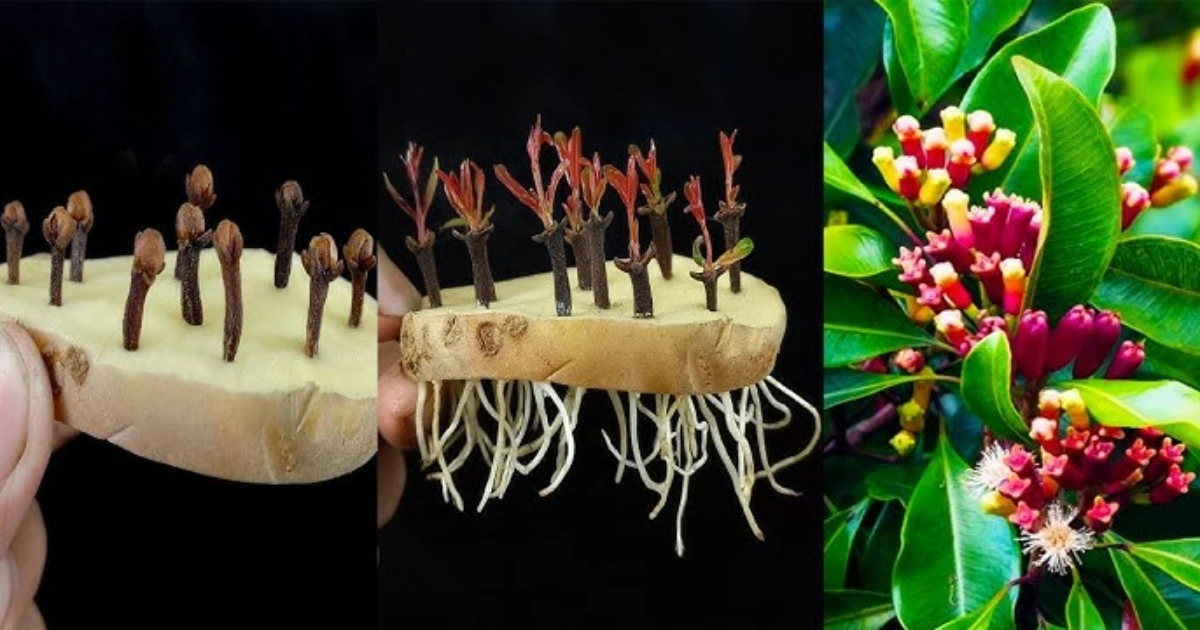Introduction
Growing your own clove plant (Syzygium aromaticum) at home is an exciting and rewarding endeavor. Cloves are not only a valuable spice but also a beautiful addition to your indoor or outdoor garden. While traditional methods of propagation involve seeds or cuttings, there’s a lesser-known technique that utilizes everyday household items—potatoes and aloe vera. This method is simple, natural, and effective, making it perfect for both novice and experienced gardeners.
Understanding the Potato and Aloe Vera Method
This innovative propagation technique involves using a potato as a nutrient-rich base and aloe vera gel to stimulate root growth. The potato provides essential nutrients and moisture, while the aloe vera gel promotes healthy root development. Together, they create an ideal environment for clove seeds to germinate and grow.
Materials Needed
- Fresh, firm potato
- Aloe vera gel (preferably fresh)
- Clove seeds (whole, not ground)
- Sharp knife or scissors
- Small container or tray
- Plastic wrap or a clear plastic bag
- Watering can or spray bottle

Step-by-Step Guide
- Prepare the Potato Base
- Select a healthy, firm potato without any signs of rot or disease.
- Cut the potato into thick slices, approximately 1 to 2 inches wide.
- Ensure each slice has at least one “eye” (the small indentations where sprouts emerge).
- Apply Aloe Vera Gel
- Extract fresh aloe vera gel from a mature leaf.
- Using a clean knife or spoon, apply a generous amount of gel to the cut surface of each potato slice.
- The aloe vera gel acts as a natural rooting hormone, encouraging the clove seeds to sprout.
- Insert Clove Seeds
- Place one or two whole clove seeds into the center of each potato slice.
- Gently press them into the potato to ensure good contact with the aloe vera gel.
- Create a Humid Environment
- Place the prepared potato slices in a shallow tray or container.
- Cover the container with plastic wrap or a clear plastic bag to retain moisture.
- Place the setup in a warm, bright location, but out of direct sunlight.
- Maintain Moisture and Temperature
- Check the potato slices daily to ensure they remain moist but not waterlogged.
- Mist with water as needed to maintain humidity.
- The ideal temperature range for germination is between 70°F and 80°F (21°C to 27°C).
- Observe Germination
- Within a few weeks, you should begin to see small roots emerging from the clove seeds.
- Once the roots are well-developed and the seedlings have a few leaves, they are ready to be transplanted into soil.
Benefits of This Method
- Cost-Effective: Utilizes common household items, reducing the need for specialized equipment.
- Natural Growth Stimulus: Aloe vera gel is a natural rooting hormone, promoting healthy root development.
- Easy to Monitor: The transparent covering allows you to observe the germination process without disturbing the seeds.
- Suitable for Beginners: This method is straightforward and ideal for those new to gardening.
Common Mistakes to Avoid
- Using Ground Cloves: Only whole, unground clove seeds will germinate. Ground cloves lack viable seeds.
- Excessive Watering: While moisture is essential, overwatering can lead to mold growth and seed rot.
- Direct Sunlight: Placing the setup in direct sunlight can cause overheating and dehydration.
- Lack of Ventilation: Ensure the container has some airflow to prevent fungal growth.
Transplanting Your Clove Seedlings
- Prepare the Soil: Choose a well-draining potting mix enriched with organic matter.
- Select a Suitable Pot: Use a pot with drainage holes to prevent waterlogging.
- Transplant Carefully: Gently remove the seedlings from the potato slices, being careful not to damage the roots.
- Acclimate Gradually: If transplanting outdoors, gradually acclimate the seedlings to outdoor conditions over a week.
Seasonal Tips for Clove Plant Care
- Spring Planting: Spring is the ideal time to start clove seeds, as the warmer temperatures promote faster germination.
- Winter Care: If growing indoors during winter, ensure the plants receive adequate light, either through natural sunlight or grow lights.
- Humidity Management: Clove plants thrive in humid environments. Regular misting or using a humidity tray can help maintain optimal conditions.
Tools & Materials Checklist
- 🥔 Fresh potato
- 🌿 Aloe vera gel
- 🌱 Whole clove seeds
- 🔪 Sharp knife or scissors
- 🧴 Watering can or spray bottle
- 🧼 Clean container or tray
- 🧻 Plastic wrap or clear plastic bag
FAQs
- Can I use this method for other spices?
- Yes, this technique can be adapted for other spices like cinnamon or nutmeg, provided you have viable seeds.
- How long does it take for clove seeds to germinate?
- Germination typically occurs within 2 to 4 weeks, depending on environmental conditions.
- Can I grow clove plants indoors year-round?
- Yes, with proper care, clove plants can thrive indoors throughout the year.
- Do clove plants require a lot of sunlight?
- Clove plants prefer bright, indirect sunlight. Avoid direct sunlight, which can scorch the leaves.
- How often should I water my clove plant?
- Water when the top inch of soil feels dry. Ensure the pot has good drainage to prevent root rot.
Conclusion
Growing clove plants at home using potatoes and aloe vera is a simple, natural, and effective method suitable for gardeners of all levels. By following the steps outlined above, you can successfully propagate clove plants and enjoy the satisfaction of cultivating your own spice. Remember to provide consistent care, monitor environmental conditions, and be patient as your clove seedlings develop into healthy, thriving plants.
Call to Action
Have you tried propagating clove plants using the potato and aloe vera method? Share your experiences and tips in the comments below. If you found this guide helpful, don’t forget to share it with fellow gardening enthusiasts!


Hi, i feel that i noticed you visited my blog so i got here to “go back the favor”.I’m trying to in finding things to enhance my site!I assume its ok to make use of a few of your ideas!!
Hi, i think that i saw you visited my web site thus i came to “return the favor”.I’m attempting to find things to improve my website!I suppose its ok to use some of your ideas!!
Definitely, what a splendid blog and instructive posts, I surely will bookmark your website.Have an awsome day!
I am so happy to read this. This is the kind of manual that needs to be given and not the random misinformation that is at the other blogs. Appreciate your sharing this best doc.
You got a very great website, Sword lily I found it through yahoo.
Thank you for your own effort on this web site. My mom really loves conducting research and it’s simple to grasp why. We all know all relating to the compelling tactic you present precious thoughts through the website and cause response from people about this concern so our girl is learning a whole lot. Enjoy the rest of the new year. You’re the one conducting a wonderful job.
I¦ll immediately snatch your rss feed as I can not to find your e-mail subscription hyperlink or newsletter service. Do you have any? Kindly permit me recognize in order that I may just subscribe. Thanks.
Hello.This article was extremely fascinating, especially because I was searching for thoughts on this matter last Friday.
https://t.me/site_official_1win/729
Fantastic blog! Do you have any tips and hints for aspiring writers? I’m hoping to start my own blog soon but I’m a little lost on everything. Would you advise starting with a free platform like WordPress or go for a paid option? There are so many options out there that I’m totally confused .. Any tips? Thanks!
https://t.me/s/iGaming_live/4866